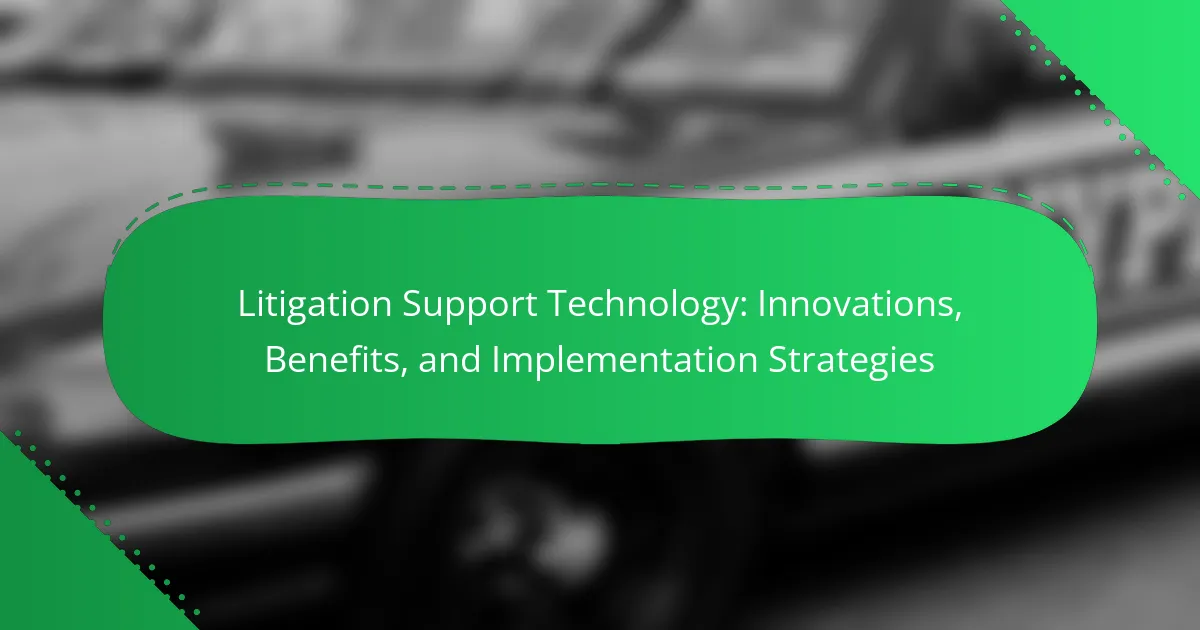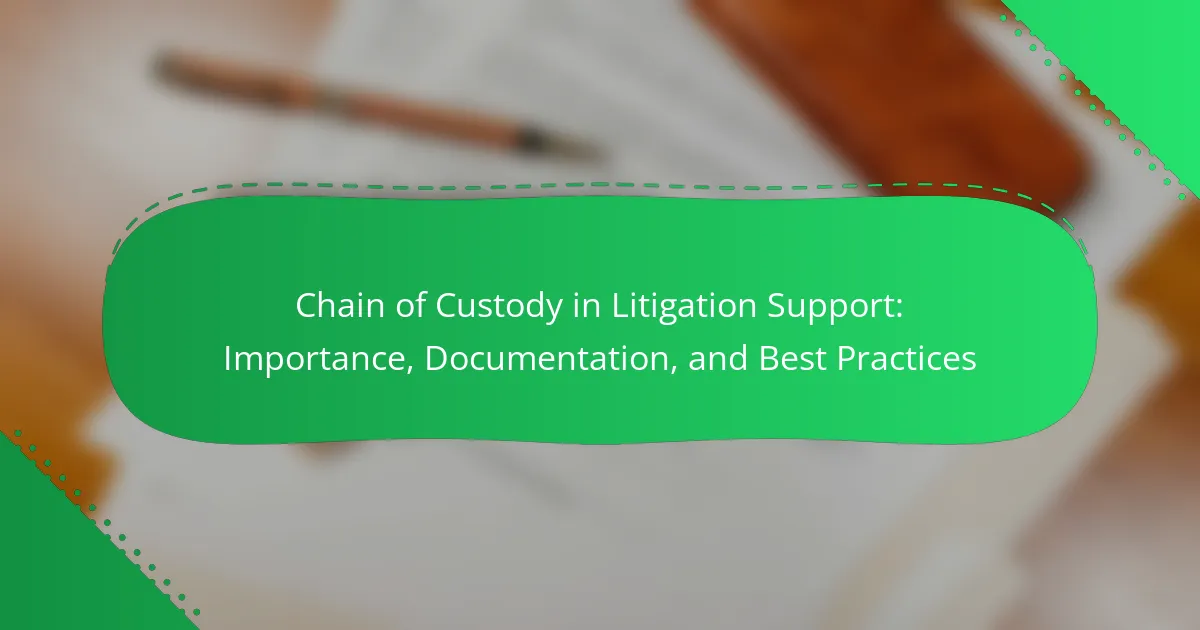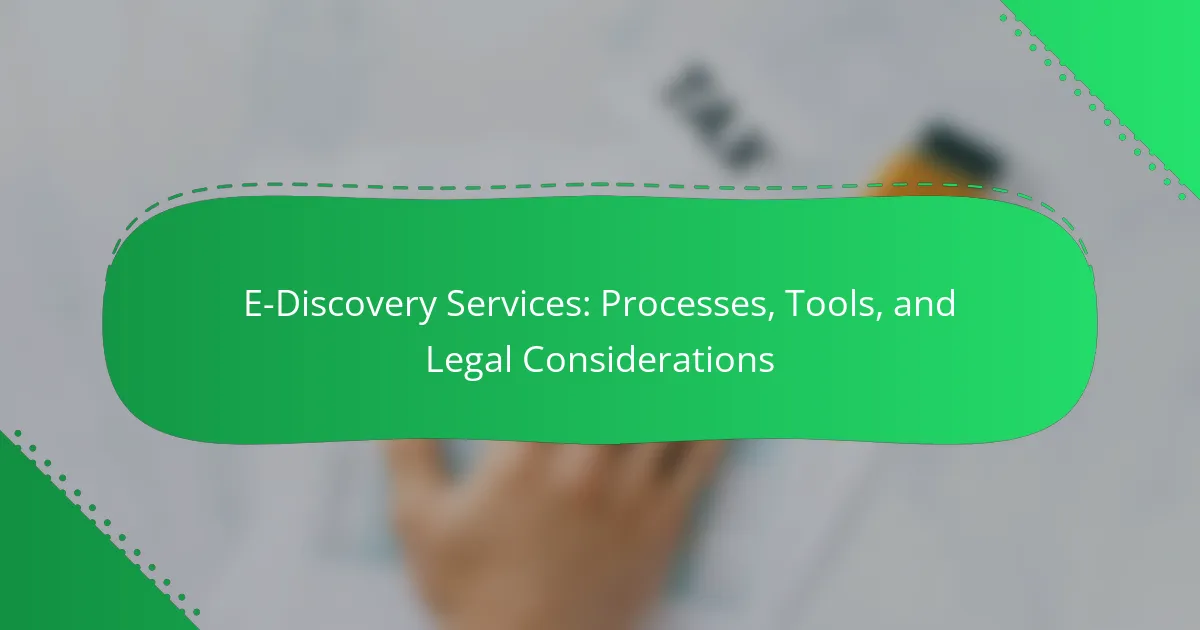Litigation Support Technology encompasses tools and systems designed to aid legal professionals throughout the litigation process. This technology includes software for document management, e-discovery, and case analysis, which enhances the organization, retrieval, and collaboration of legal documents. The article outlines best practices for implementing this technology, emphasizing the importance of needs assessment, stakeholder engagement, and effective training. It also examines future trends such as increased automation, artificial intelligence integration, and enhanced cybersecurity measures, all aimed at streamlining litigation processes and improving outcomes for legal teams.
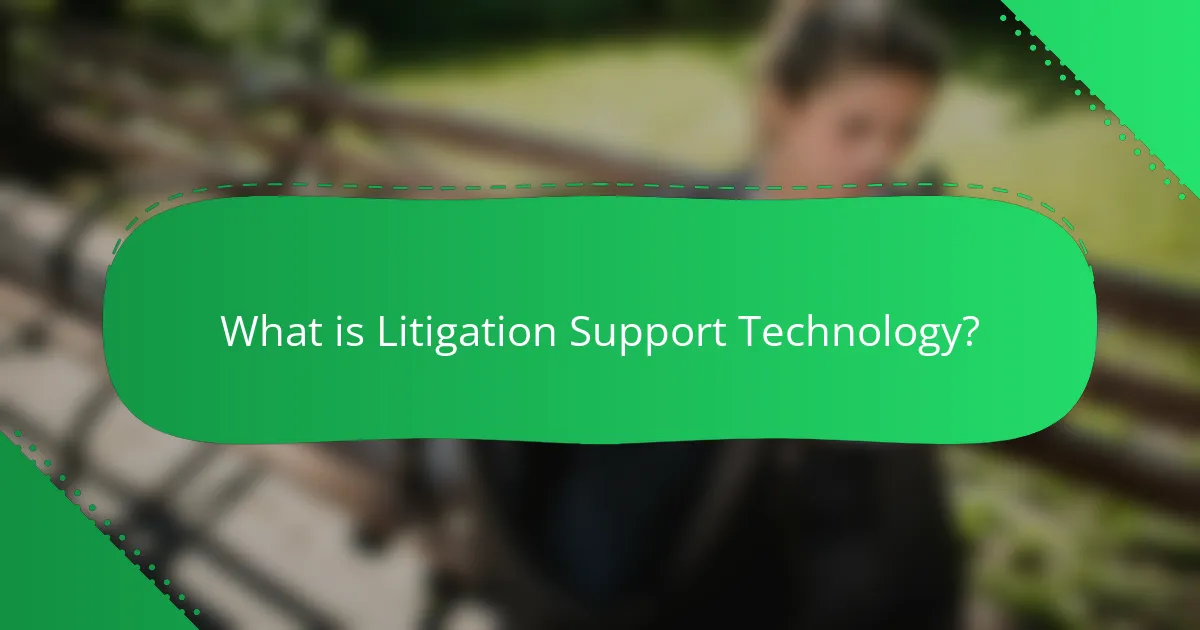
What is Litigation Support Technology?
Litigation Support Technology refers to tools and systems that assist legal professionals during litigation processes. This technology includes software for document management, e-discovery, and case analysis. It streamlines the organization and retrieval of legal documents. Additionally, it enhances collaboration among legal teams. Data analytics features help identify patterns and insights in large volumes of information. The use of such technology can lead to increased efficiency and reduced costs in legal proceedings. A study by the American Bar Association indicates that 97% of lawyers believe technology significantly improves their practice.
How does Litigation Support Technology function in legal processes?
Litigation Support Technology functions by streamlining various legal processes. It assists in managing case documents, evidence, and data analysis. This technology facilitates electronic discovery, enabling lawyers to efficiently search and retrieve relevant information. It also supports case management through tools that organize timelines and track deadlines. Additionally, it enhances collaboration among legal teams by providing shared access to documents and communication platforms. Research indicates that firms using litigation support technology experience increased efficiency and reduced costs. For instance, a study published in the “Journal of Legal Technology Risk Management” found that 75% of firms reported improved case outcomes due to these tools.
What are the key components of Litigation Support Technology?
The key components of Litigation Support Technology include case management systems, document management systems, and electronic discovery tools. Case management systems help organize case files and track deadlines. Document management systems enable efficient storage and retrieval of legal documents. Electronic discovery tools assist in the identification, collection, and analysis of electronic data. These components streamline workflows and enhance collaboration among legal teams. They also improve accuracy and reduce the time spent on case preparation. The integration of these technologies can lead to more effective litigation strategies and better outcomes for clients.
How do these components integrate with traditional legal practices?
Litigation support technology integrates with traditional legal practices by enhancing efficiency and accuracy. These components streamline document management, case analysis, and communication. For example, e-discovery tools automate the process of identifying relevant documents, which reduces time and costs. Additionally, case management software organizes case-related information, making it easily accessible. Legal analytics provide insights into case outcomes based on historical data, aiding lawyers in strategy formulation. Research shows that firms using litigation support technology experience improved productivity and client satisfaction. According to a 2021 survey by the American Bar Association, 70% of legal professionals reported enhanced workflow efficiency due to technology integration.
What innovations are driving Litigation Support Technology?
Artificial intelligence and machine learning are driving innovations in litigation support technology. These technologies enhance document review processes by automating the identification of relevant information. Predictive coding algorithms help prioritize documents based on their relevance to a case. Cloud-based solutions enable remote access to case files and collaboration among legal teams. Data analytics tools provide insights into case trends and outcomes. E-discovery platforms streamline the collection and processing of electronic evidence. Blockchain technology offers secure and tamper-proof documentation of evidence and transactions. These innovations improve efficiency and accuracy in legal proceedings.
How are artificial intelligence and machine learning enhancing Litigation Support Technology?
Artificial intelligence and machine learning are enhancing Litigation Support Technology by automating document review processes. They significantly reduce the time needed to analyze large volumes of data. AI algorithms can identify relevant case law and legal precedents more efficiently than traditional methods. Machine learning models improve over time by learning from previous cases. This leads to increased accuracy in predicting outcomes based on historical data. Additionally, AI tools assist in e-discovery, streamlining the collection and organization of evidence. Studies show that these technologies can decrease litigation costs by up to 30%. Overall, AI and machine learning are transforming the efficiency and effectiveness of legal practices.
What role does cloud computing play in modern Litigation Support Technology?
Cloud computing plays a crucial role in modern Litigation Support Technology by enhancing data accessibility and collaboration. It allows legal teams to access case files and documents from anywhere at any time. This flexibility improves efficiency and responsiveness in legal proceedings. Cloud solutions also provide scalable storage options, accommodating large volumes of data typical in litigation. Furthermore, cloud computing ensures data security through encryption and regular backups. This minimizes the risk of data loss and unauthorized access. The integration of cloud services facilitates real-time updates and communication among team members. Such capabilities are essential in fast-paced legal environments. Overall, cloud computing significantly streamlines litigation processes and improves case management.
What benefits does Litigation Support Technology provide to legal professionals?
Litigation Support Technology enhances the efficiency and effectiveness of legal professionals. It streamlines document management, allowing quick access to relevant information. This technology improves collaboration among legal teams, facilitating real-time communication. It also aids in data analysis, enabling lawyers to identify key evidence and trends. Furthermore, it supports e-discovery processes, reducing the time and cost associated with legal proceedings. According to a study by the American Bar Association, firms using litigation support tools reported increased productivity and better case outcomes. These benefits underscore the importance of adopting such technology in legal practice.
How does Litigation Support Technology improve case management?
Litigation Support Technology improves case management by streamlining document organization and retrieval. It allows legal teams to efficiently manage large volumes of data. This technology automates tasks such as e-discovery and document review. As a result, it reduces the time spent on manual processes. Enhanced collaboration tools facilitate communication among team members. These tools also enable real-time updates and tracking of case progress. According to a study by the American Bar Association, technology adoption can increase productivity by up to 30%. Overall, Litigation Support Technology enhances accuracy and efficiency in managing legal cases.
What cost savings can be realized through the use of Litigation Support Technology?
Litigation Support Technology can lead to significant cost savings in various ways. First, it reduces the time required for document review and analysis. This efficiency can cut labor costs dramatically. Second, it minimizes errors in data handling, which can prevent costly mistakes in legal proceedings. Third, it enhances collaboration among legal teams, streamlining communication and reducing the need for extensive meetings. Fourth, it allows for better case management, leading to more strategic resource allocation. According to a study by the American Bar Association, firms that utilized litigation support technology reported up to a 30% reduction in overall litigation costs. This indicates that the implementation of such technology can be a financially savvy decision for legal practices.

What are the best practices for implementing Litigation Support Technology?
The best practices for implementing Litigation Support Technology include thorough needs assessment and stakeholder engagement. Conducting a needs assessment ensures alignment with case requirements. Engaging stakeholders fosters buy-in and smooth adoption. Selecting the right technology is crucial for meeting specific legal needs. Training staff effectively enhances usage and maximizes benefits. Establishing clear workflows improves efficiency and reduces errors. Regularly evaluating technology performance ensures it meets evolving needs. Adhering to data security protocols protects sensitive information. These practices lead to successful implementation and optimized outcomes in legal proceedings.
How should legal firms assess their needs for Litigation Support Technology?
Legal firms should assess their needs for Litigation Support Technology by evaluating specific case requirements. They must identify the volume of documents and data involved in cases. Understanding the types of cases they handle helps in selecting appropriate technology. Firms should consider their budget for technology investments. They must also assess the technical expertise of their staff. Evaluating existing workflows is essential to determine integration needs. Gathering feedback from users can highlight specific challenges and needs. Industry benchmarks can provide insights into standard practices and tools used by similar firms.
What factors should be considered when selecting Litigation Support Technology tools?
When selecting Litigation Support Technology tools, consider functionality, compatibility, and user-friendliness. Functionality includes the features that meet specific case needs, such as document management and e-discovery capabilities. Compatibility ensures the tool integrates seamlessly with existing systems and software. User-friendliness affects how quickly team members can adapt to the technology.
Additionally, evaluate vendor support and training resources. Reliable vendor support can enhance the tool’s effectiveness. Training resources are crucial for ensuring all users can utilize the technology effectively. Cost is another important factor; assess the total cost of ownership versus the expected return on investment.
Finally, consider security features to protect sensitive data throughout the litigation process. These factors contribute to selecting the most effective Litigation Support Technology tools to enhance case management and outcomes.
How can firms ensure successful training and adoption of these technologies?
Firms can ensure successful training and adoption of litigation support technologies by implementing structured training programs. These programs should be tailored to the specific technologies being adopted. Training should include hands-on sessions and real-world scenarios relevant to the firm’s operations. Additionally, firms should provide continuous support and resources post-training to reinforce learning. Regular feedback sessions can help identify areas for improvement in the training process. Data shows that firms with comprehensive training programs experience a 30% increase in technology adoption rates. Investing in user-friendly interfaces can also enhance the adoption process.
What common challenges arise during the implementation of Litigation Support Technology?
Common challenges during the implementation of Litigation Support Technology include resistance to change, inadequate training, and integration issues with existing systems. Resistance to change often stems from users’ comfort with current processes. Inadequate training can lead to underutilization of the technology, resulting in poor adoption rates. Integration issues may arise when the new technology does not seamlessly connect with legacy systems, causing data silos. Furthermore, budget constraints can limit the resources available for successful implementation. According to a survey by the International Legal Technology Association, 60% of firms reported integration difficulties as a significant barrier. These challenges can hinder the overall effectiveness of litigation support technology.
How can firms overcome resistance to new technologies?
Firms can overcome resistance to new technologies by fostering a culture of openness and continuous learning. This involves providing comprehensive training programs that enhance employee skills and confidence. Research shows that 70% of employees feel more engaged when they receive proper training on new tools. Additionally, involving employees in the decision-making process can increase their buy-in. When staff members feel their input is valued, they are more likely to embrace changes. Clear communication about the benefits and objectives of new technologies also plays a crucial role. Providing data on how these tools can improve efficiency and outcomes can help alleviate concerns. Lastly, offering ongoing support and resources ensures that employees can adapt to changes effectively.
What strategies can be used to address data security concerns?
Implementing strong encryption is a key strategy to address data security concerns. Encryption protects sensitive information by converting it into an unreadable format for unauthorized users. Regularly updating software and systems also enhances security. Vulnerabilities in outdated software can be exploited by attackers. Conducting regular security audits identifies potential weaknesses in the system. Organizations can then take corrective actions to mitigate risks. Employee training on data security practices is essential. Well-informed staff can recognize phishing attempts and other threats. Implementing access controls ensures that only authorized personnel can access sensitive data. According to a study by the Ponemon Institute, organizations that implement these strategies significantly reduce the risk of data breaches.
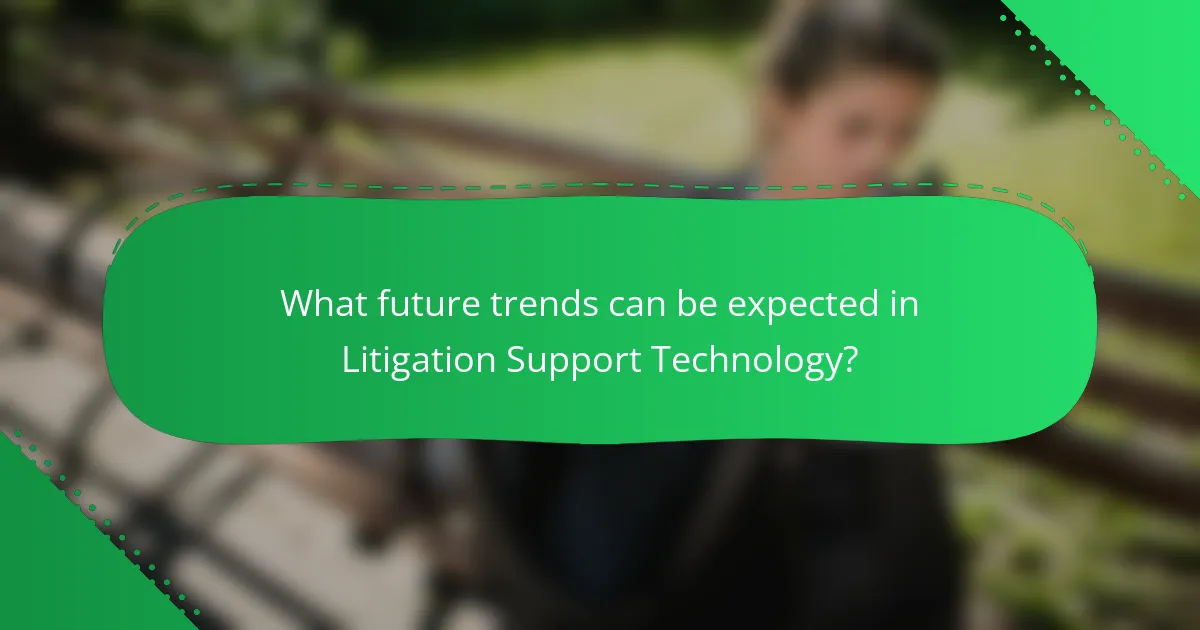
What future trends can be expected in Litigation Support Technology?
Future trends in litigation support technology include increased automation and artificial intelligence integration. AI tools will enhance document review processes, reducing time and costs. Cloud-based solutions will become more prevalent, allowing for easier collaboration among legal teams. Data analytics will play a significant role in case strategy development. Predictive coding will improve the accuracy of e-discovery. Enhanced cybersecurity measures will be essential to protect sensitive information. Virtual reality may be used for trial simulations and witness preparation. Overall, these trends will streamline litigation processes and improve outcomes for legal professionals.
How is Litigation Support Technology evolving with legal industry demands?
Litigation Support Technology is evolving to meet the increasing demands of the legal industry. This evolution is driven by the need for greater efficiency and accuracy in legal processes. Technologies such as artificial intelligence and machine learning are being integrated into litigation support systems. These technologies help in document review and case analysis, significantly reducing time and costs. Additionally, cloud-based solutions are becoming more prevalent, allowing for better collaboration among legal teams. The rise of remote work has accelerated the adoption of these technologies. Data security measures are also evolving to protect sensitive information in compliance with regulations. Overall, the evolution of Litigation Support Technology reflects the legal industry’s shift towards more innovative and efficient practices.
What emerging technologies are likely to impact Litigation Support Technology?
Artificial intelligence and machine learning are emerging technologies likely to impact Litigation Support Technology. These technologies enhance document review processes through automation and predictive coding. Natural language processing improves search capabilities and data extraction efficiency. Blockchain technology offers secure and transparent data management for legal documentation. Cloud computing enables remote access and collaboration among legal teams. Data analytics provides insights into case strategies and outcomes. These advancements streamline workflows and reduce costs in litigation support.
How can legal professionals prepare for future advancements in Litigation Support Technology?
Legal professionals can prepare for future advancements in Litigation Support Technology by staying informed about emerging technologies. They should regularly attend industry conferences and workshops focused on legal technology. Engaging in continuous education through online courses can enhance their understanding of new tools. Networking with technology vendors can provide insights into upcoming innovations. Additionally, adopting a proactive approach to integrating technology into their practices is essential. This includes piloting new software and tools in their workflows. Keeping abreast of legal tech publications can also offer valuable updates on trends. By taking these steps, legal professionals can effectively adapt to advancements in Litigation Support Technology.
What practical tips can enhance the effectiveness of Litigation Support Technology?
Utilizing Litigation Support Technology effectively requires strategic implementation. First, ensure proper training for all users. Trained personnel can navigate software and systems efficiently. Second, integrate technology with existing workflows. This alignment minimizes disruption and enhances productivity. Third, regularly update software to access the latest features and security enhancements. Outdated systems may lead to inefficiencies. Fourth, maintain clear communication among team members. Effective communication facilitates collaboration and problem-solving. Finally, evaluate technology performance periodically. Regular assessments help identify areas for improvement and ensure optimal use.
Litigation Support Technology encompasses tools and systems that assist legal professionals in managing litigation processes, including document management, e-discovery, and case analysis. This article explores the functionality, key components, and innovations driving this technology, as well as its integration with traditional legal practices. It highlights the benefits such as increased efficiency, reduced costs, and improved case management, while also addressing best practices for implementation and common challenges faced by legal firms. Additionally, the article discusses future trends and emerging technologies that may impact the field, offering practical tips for legal professionals to enhance their use of litigation support technology.
